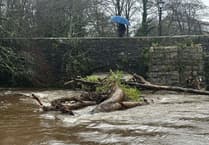A DEBATE over use of land close to Rame Head continues to polarise opinion.
Farmer Chris Wilton’s latest application to erect a barn on a field opposite the Ramehead Cottages has been rejected by Cornwall Council on the grounds that the scale and location of the building “would result in an unacceptable visual impact on the surrounding landscape, detracting from the exceptional scenic beauty of the Cornwall Area of Outstanding Natural Beauty”.
Mr Wilton first put in a prior notification application for agricultural development in November 2022. The 290sqm barn proposed would be used to store straw bales, grain and farm machinery.
The November application was rejected, with the planning officer stating that it had not been suitably demonstrated that the land in question was agricultural – and that a full application would in any case be required in order to assess the visual impact of the barn.
In the meantime, the applicant has provided further information to Cornwall Council’s planning department about the use of the land.
The local authority has now agreed that the land can be classified as agricultural. Therefore ‘permitted development’ rules would apply, whereby certain types of building for agricultural use can be allowed without going through the full planning process. Nonetheless, the applicant was told in this instance that the proposed barn would fail to adhere to various local, Cornish and national planning policies due to its setting, and that therefore it could not be approved.
The conversation about the development has stoked a long-running and acrimonious debate about Chris Wilton’s plans for the site.
Mr Wilton had originally hoped to build a family home, a project which was the subject of two planning applications, a judicial review, an appeal and an eventual rejection by the planning inspectorate.
In an unusual move, agents ADW Design Group submitted a long document directly addressing some of the objectors’ comments, and setting out further information in support of the barn.
In this document they state that should the new barn not be possible, an even taller stack of bales, covered over with black sheeting, will be needed.
“If the barn is not provided,” said the agent, “the external storage of bales will be even higher, as in addition to the barn height a three-bale sacrificial top will be required and then to be sheeted over causing more visual disruption to the landscape.
“Without a roof to protect the bales, the stack will need to be in the region of 10-12m high, providing more vertical sides to protect against water ingress and minimising the exposed area of the top of the stack which is at risk of water ruining the straw.
“Additionally, the top and possible sides may need to be sheeted with black plastic sheeting to keep the water off, increasing noise (from the wind), and visual impact, adversely impacting the biodiversity due to the noise, and /or appearance.”

.jpg?width=209&height=140&crop=209:145,smart&quality=75)



Comments
This article has no comments yet. Be the first to leave a comment.